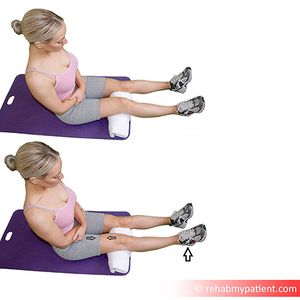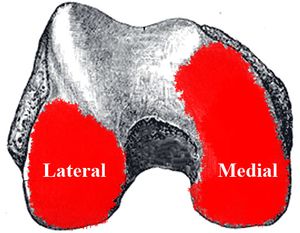Screw Home Mechanism of The Knee Joint: Difference between revisions
No edit summary |
No edit summary |
||
| Line 11: | Line 11: | ||
* Rotation must occur to achieve full extension and then flexion from full extension. | * Rotation must occur to achieve full extension and then flexion from full extension. | ||
== Relevant Anatomy == | |||
[[File:Conyle inequality femur.jpg|Articular surface paradox of femur|right|frameless]]The knee joint is basically a hinge joint with the main movement of flexion-extension. However, the radius and the length of the articular surface of the femur and tibia differ at the knee joint ie Articular surface of medial condyle of femur is greater than the articular surface of later condyle. | |||
* As a result, a complex movement (includes "sliding") occurs during the last 30 degrees of knee extension, in addition to rolling between the two bones this allows the knee joint to move smoothly. | |||
* At terminal extension, the knee joint is slightly hyperextended and stabilized with the tightening of the cruciate and collateral ligaments. | |||
* As the length of the medial femoral condyle is longer than the length of the lateral condyle, the tibia rotates externally about 15° on the femur during the last 20° of extension. | |||
* This kinematic phenomenon is well known, and it is called the screw-home movement | |||
Also you can check [[Knee|anatomy of knee]] section in Physiopedia. | Also you can check [[Knee|anatomy of knee]] section in Physiopedia. | ||
=== Clinical Manifestations of Screw Home Mechanism === | === Clinical Manifestations of Screw Home Mechanism === | ||
Revision as of 07:05, 12 September 2020
Definition[edit | edit source]
Screw home mechanism (SHM) of knee joint is a critical mechanism that play an important role in terminal extension of the knee.
- There is an observable rotation of the knee during flexion and extension.
- During the last 30 degrees of knee extension, the tibia (open chain) or femur (closed chain) must externally or internally rotate, respectively, about 10 degrees.
This rotation is important for healthy movement of the knee.[1][2][3][4][5][6].
- This slight rotation in the last 15 degrees of knee extension is due to inequality of the articular surface of femur condyles.
- Tibial-on-femoral rotation occurs in an open chain exercise like in the leg extension machine, tibia externally rotates.
- Femoral-on-tibial rotation, as in a closed chain exercise like the squat, femur internally rotates
- Rotation must occur to achieve full extension and then flexion from full extension.
Relevant Anatomy[edit | edit source]
The knee joint is basically a hinge joint with the main movement of flexion-extension. However, the radius and the length of the articular surface of the femur and tibia differ at the knee joint ie Articular surface of medial condyle of femur is greater than the articular surface of later condyle.
- As a result, a complex movement (includes "sliding") occurs during the last 30 degrees of knee extension, in addition to rolling between the two bones this allows the knee joint to move smoothly.
- At terminal extension, the knee joint is slightly hyperextended and stabilized with the tightening of the cruciate and collateral ligaments.
- As the length of the medial femoral condyle is longer than the length of the lateral condyle, the tibia rotates externally about 15° on the femur during the last 20° of extension.
- This kinematic phenomenon is well known, and it is called the screw-home movement
Also you can check anatomy of knee section in Physiopedia.
Clinical Manifestations of Screw Home Mechanism[edit | edit source]
Terminal Knee Extention Exercise[edit | edit source]
Terminal knee extention is a specific exercise for vastus medialis obliquus muscle. In earlier descriptions of the exercise it is sugested to improve muscle force of vastus medialis obliquus. Further descriptions also focused on motor leraning and vastus medialis obliquus time delay during terminal extention.

Clinical Relevelance[edit | edit source]
In most of the knee problems generally there is an insufficiency on terminal extension and vastus medialis obliquus function. Restoration of terminal extension is an important goal of rehabilitation program. Terminal extension exercises like interventions have important contribution on restoration of screw home movement /terminal extension.
References[edit | edit source]
- ↑ Goodfellow J, O'Connor J. The mechanics of the knee and prosthesis design. J Bone Joint Surg Br. 1978;60(3):358–369.
- ↑ Bytyqi D, Shabani B, Lustig S, Cheze L, Karahoda Gjurgjeala N, Neyret P. Gait knee kinematic alterations in medial osteoarthritis: three dimensional assessment. Int Orthop. 2014;38(6):1191–1198.
- ↑ Ishii Y, Terajima K, Terashima S, Koga Y. Three-dimensional kinematics of the human knee with intracortical pin fixation. Clin Orthop Relat Res. 1997;(343):144–150.
- ↑ https://www.ncbi.nlm.nih.gov/pubmed/12135550
- ↑ Asano T, Akagi M, Tanaka K, Tamura J, Nakamura T. In vivo three-dimensional knee kinematics using a biplanar imagematching technique. Clin Orthop Relat Res. 2001;(388):157–166
- ↑ Kim, H. Y., Kim, K. J., Yang, D. S., Jeung, S. W., Choi, H. G., & Choy, W. S. (2015). Screw-Home Movement of the Tibiofemoral Joint during Normal Gait: Three-Dimensional Analysis. Clinics in orthopedic surgery, 7(3), 303–309. doi:10.4055/cios.2015.7.3.303







